One Colorado Newbie’s Experience
Article and Photos by Karen Vanderwall
This is the first in a series of articles focusing on the experiences of members creating a native garden from the beginning.
When we first moved to Fort Collins three years ago, we came with the knowledge that water was a precious resource here. We have family in Colorado so knew well before our move how dry the conditions are in the area. Our public radio station in North Carolina had reported about the drought in Colorado, the state of the Colorado River, its use–or more accurately overuse, shortages, and the search for long-term solutions. We came to the state aware of the situation and determined not to be part of the problem by not using irrigation water whenever possible.
Coming from an area with an average annual rainfall of 42 inches per year to an area with an average of 16, I swallowed and was determined to learn about how to create a garden using very little water, with intense sun and extreme temperatures. I’ve always been a gardener who enjoys using the space and conditions I’ve got to work with and was up to the challenge!
In the Beginning
The property was first developed in 1977 but there was an addition added to the side of the house (shown in the photo) in 2019, prior to our purchase of the property. It was clear there was some compaction of the lawn from the new construction as the grass was struggling. I considered incorporating native grass seed and aerating. But the area was just off the deck, a prime spot for a garden. I knew I wanted to have a wildflower garden and was reading about drought tolerant plants that required the amount of water that naturally came from mother nature. Using Colorado native plants was the answer.
It was an easy decision for both my husband and I to make – swapping out a high labor and resource intensive grass lawn for one that will foster higher biodiversity, require fewer resources like water and chemicals and contribute to the surrounding ecosystem as a whole. I should probably mention that my husband mows the grass and any reduction in the size of the lawn met with glowing approval, so I had that going for me too!
First Steps


I had more available time after moving, allowing me the unique opportunity to create a large garden. I started designing the garden in March 2023 with the basics of site and design planning. We do not have a strict homeowners association, but my neighbors are a tidy bunch, so I knew I wanted to give some attention to design in terms of both shape and plants.
In May we began to move the plan outside. I used some garden hoses around to play with the shape of the garden. There is landscaping around the perimeter of the property with landscaped beds that are curved roughly following the topography of the land and demarcated by metal edging. I drew from the established landscaping in designing the native garden to keep the continuity. Once the shape was determined, the next step was figuring out how I wanted to remove the turf.
Because of the slope, I wanted to take advantage of the turf grass root system to provide soil stability, so I didn’t want to remove the grass. I also wanted to let the dead grass break down slowly so it would act as a natural mulch.
Since it was to be a native garden, I didn’t need to amend the soil. In addition, the area was pretty big – roughly 50 feet by 90 feet – so that ruled out the cardboard smothering option since that would be a lot of cardboard and mulch. After doing a lot of research, I decided to use a chemical herbicide to kill the grass. While it is admirable to not use chemical herbicides when doing turf removal, in large projects, if you are very careful, it seems safe to use.
From Lawn to Habitat
We waited a few days for the grass to die and began making the garden in earnest. The short dead grass and roots were left but the soil was somewhat compacted so before planting anything I loosened the soil with a gravel rake.
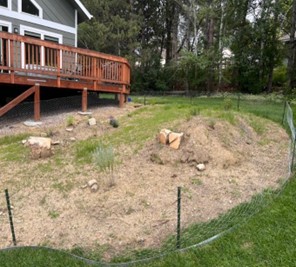
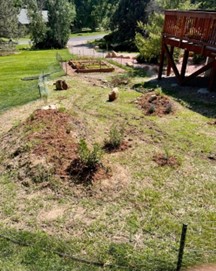
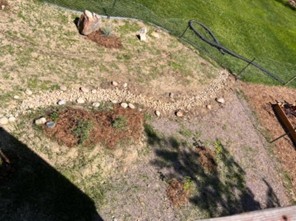
I then broadcasted Colorado native wildflower and grass seed. I had left a few areas for adding specific native plants and shrubs for focal points. We had some soil/sod from making raised beds so I used those to add some topography. I also found rocks around the property to add to the design.
Before long, it was June and things began to grow! I was thrilled! I worked on mulching around the nursery sourced plants I had planted and decided on where I wanted a path. I used grass clippings for the first phase of the path. I also made a narrow stone creek bed where, from observation, rainwater naturally flowed.
Since the native seeds were just beginning to germinate, there was plenty of room for weed seeds to germinate as well. Using plant identification apps and my limited knowledge of some of the noxious weeds that grow in Colorado, I went to work weeding. I decided that it would be respectful of neighbors, local farmers as well as the environment as a whole to pull as many exotic invasives I had time for. This was particularly important that first year, even with mulching. The garden would definitely benefit and pulling them before they went to seed would help me in the long run. July was spent identifying seedlings which was a lot of fun and pulling weeds (not as much fun).
Into August, the garden began maturing and blooming! Of course, with summer comes vacations, travel and visits with family and friends so the garden got weeded with in-between those events.
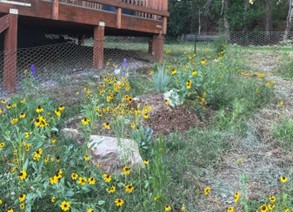
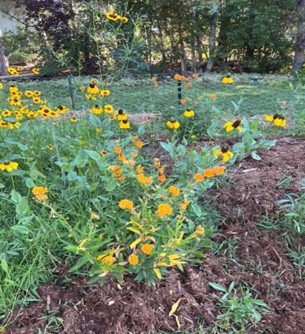
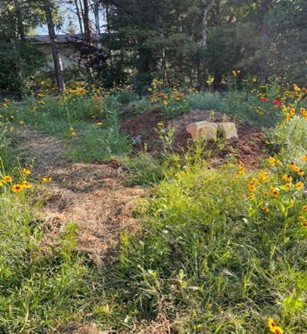
By the end of August, it was clear that all the work really paid off. The sturdy plants that tolerate dry disturbed ground such as Mexican hat dominated for which I was grateful as they outcompeted weeds. I replaced the grass clippings on the path (too many weeds) with wood chip mulch.
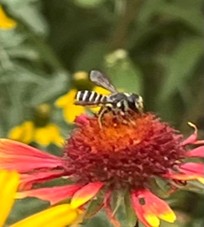
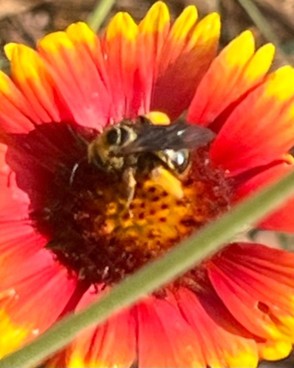
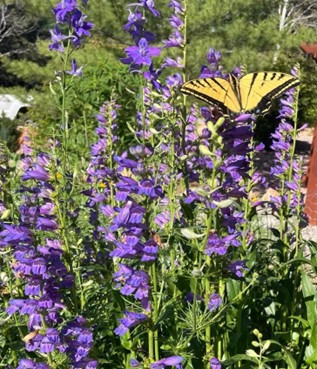
Second Year
By the second year, the native garden (and now native gardener) felt much more established. In May of the second year, many of the perennials came back and all the weeding the year before seemed made a difference. There was now more time to do a lot more observing and watching the garden grow.
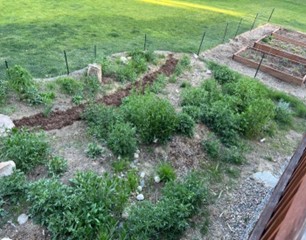
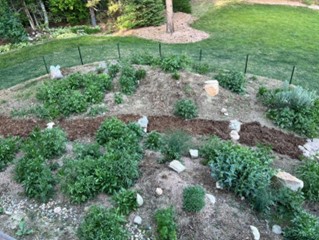
Since this is a beginner garden article I will bring this to a close with a couple of comments about the second year:
I continued to weed, but much less than the year before. In addition to noxious weeds, I found there are other kinds of weeds. The definition of a weed is a plant out of place. Since I created this garden, even though it was a native garden, it was up to me to decide if any plants were out of place. As the season began in full, first the Mexican hat (Ratibida columnifera) then later in the season the pioneer species, Black eyed Susan (Rudbeckia hirta) really took over. Although very natural and beautiful, in order to have the diversity I sought, I knew I needed to weed out some of these more aggressive plants to leave space and resources for other less opportunistic species to have a chance. It worked like a charm, and I also found that the tough Mexican hat and Black-eyed Susan type plants that I left, provided shade from the scorching sun and structure that was beneficial for species that require more shade and support.
The second is that although I still needed my plant app to verify and differentiate weed from intentional plants, I also began to identify pollinators – many many pollinators. Awesome!!
